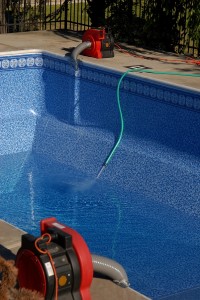A swimming pool pump is a water pump that helps keep your swimming pool clean and sanitary. There are many steps to maintaining a swimming pool, but the most important ones are dependent on a swimming pool pump that circulates water quietly, day after day, with no lapse in performance.
 The water is forced through a filter by the pump, and is recirculated into the pool. This keeps water from becoming stagnant, and ensures that proper levels of chlorine are equally distributed throughout the pool. The filter must be kept clean at all costs, and free of debris.
The water is forced through a filter by the pump, and is recirculated into the pool. This keeps water from becoming stagnant, and ensures that proper levels of chlorine are equally distributed throughout the pool. The filter must be kept clean at all costs, and free of debris.
When opening the pool, you must first remove all water and debris that have accumulated on the pool cover. Then, make sure all equipment that needs to be attached or plugged in are ready to go. Clean all of the equipment, including the skimmers and drains. Then, remove all of the debris that has accumulated in the pool.
If you see any algae, scrub it off of the pool, then add enough water to bring the pool to the desired level. You should always test the water for calcium, pH, total alkalinity, and free chlorine. Once you have done all of this, you are ready to turn on the pump and the filter. Run them for about three hours. In the meantime, you can check filters, drains, and skimmers to make sure they are working properly. Your free available chlorine should be between 1.0 and 3.0 PPM when you are going to use the pool.
When closing the pool, you need to adjust the pH level; it should be between 7.2 and 7.6, and then use a shock treatment to further adjust the pH. Then, remove all equipment, such as pool ladders, diving boards, furniture, or ropes. If you are heating the pool, turn the heater off.
You must also run the filter for one or two days without turning it off, vacuum and brush the pool walls and the floor, making sure to remove all debris. Remember to plug the fittings on the return lines with expandable rubber plugs. Use a submersible pump to drain the pool to at least 18 inches below the skimmers. Then, drain and flush the hoses. Remember to turn off the electricity to the pool.
To finish up, recheck the pH, and put a cover on the pool.
